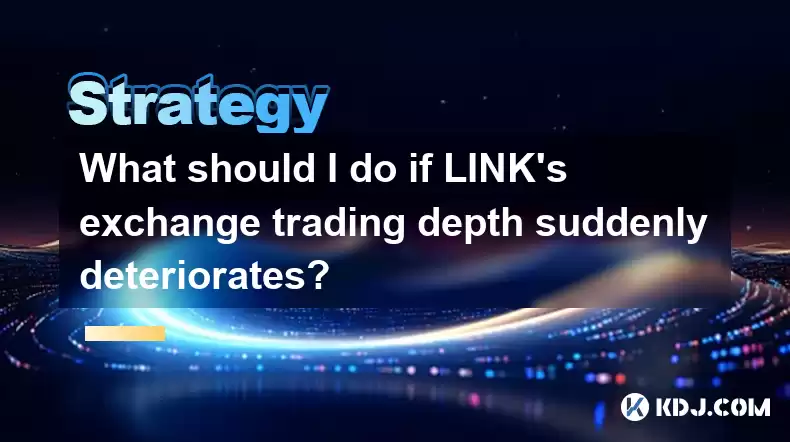-
 bitcoin
bitcoin $110918.433029 USD
-1.69% -
 ethereum
ethereum $3996.872473 USD
-2.43% -
 tether
tether $1.000594 USD
0.00% -
 bnb
bnb $1178.871834 USD
-2.38% -
 xrp
xrp $2.413973 USD
-3.47% -
 solana
solana $194.341461 USD
-4.24% -
 usd-coin
usd-coin $0.999963 USD
-0.03% -
 tron
tron $0.320092 USD
0.92% -
 dogecoin
dogecoin $0.196919 USD
-3.42% -
 cardano
cardano $0.669585 USD
-3.63% -
 hyperliquid
hyperliquid $37.485952 USD
-3.58% -
 ethena-usde
ethena-usde $1.000026 USD
-0.02% -
 chainlink
chainlink $18.018220 USD
-5.13% -
 bitcoin-cash
bitcoin-cash $523.879267 USD
-2.41% -
 stellar
stellar $0.324655 USD
-3.67%
What should I do if LINK's exchange trading depth suddenly deteriorates?
If LINK's trading depth on an exchange suddenly worsens, monitor the market closely, adjust your trading strategy, and consider diversifying across platforms to mitigate risks.
Apr 27, 2025 at 10:49 am

If you find that the trading depth of LINK (Chainlink) on an exchange suddenly deteriorates, it's crucial to understand what this means and how to respond effectively. Trading depth refers to the volume of buy and sell orders at various price levels within an order book. A deterioration in trading depth indicates a decrease in liquidity, which can lead to increased volatility and potential difficulties in executing trades at desired prices.
Understanding Trading Depth Deterioration
Trading depth deterioration can occur due to several factors, including market manipulation, significant price movements, or a sudden withdrawal of liquidity by major market participants. When the depth of the order book decreases, it becomes harder to buy or sell large amounts of LINK without significantly impacting the market price. This situation can be particularly challenging for traders who rely on stable liquidity to execute their strategies.
Immediate Actions to Take
If you notice a sudden deterioration in LINK's trading depth, here are some immediate steps you can take:
- Monitor the Market Closely: Keep an eye on the order book and trading volume to understand the extent of the liquidity drop. Use real-time market data tools to stay updated on any changes.
- Adjust Your Trading Strategy: If you were planning to execute large trades, consider breaking them into smaller orders to minimize the impact on the market price. This approach can help you avoid slippage, which is the difference between the expected price of a trade and the price at which the trade is executed.
- Diversify Your Trading Platforms: If the liquidity issue is specific to one exchange, consider using other platforms where LINK might have better trading depth. Diversifying your trading across multiple exchanges can help mitigate the risk of liquidity problems on a single platform.
Long-Term Strategies to Mitigate Risks
To better prepare for future instances of trading depth deterioration, consider implementing the following long-term strategies:
- Use Limit Orders: Instead of using market orders, which can be more susceptible to slippage in low liquidity environments, use limit orders. Limit orders allow you to specify the price at which you are willing to buy or sell, giving you more control over your trades.
- Build a Liquidity Network: Engage with other traders and liquidity providers to build a network that can help maintain or improve liquidity. Participating in decentralized finance (DeFi) platforms that offer liquidity pools can also be beneficial.
- Stay Informed About Market News: Keep up-to-date with news and developments that could impact LINK's liquidity. Regulatory changes, technological updates, or shifts in market sentiment can all affect trading depth.
Analyzing the Causes of Deterioration
Understanding the root causes of trading depth deterioration can help you anticipate and respond to similar situations in the future. Common reasons include:
- Market Manipulation: Large traders or groups may intentionally withdraw liquidity to manipulate prices. This can create artificial scarcity and drive up volatility.
- Sudden Price Movements: Rapid price changes can cause traders to pull their orders from the market, leading to a temporary drop in liquidity.
- Exchange-Specific Issues: Technical problems or policy changes on a specific exchange can impact its liquidity. For example, if an exchange introduces new fees or restrictions, it might drive away liquidity providers.
Tools and Resources for Monitoring Liquidity
To effectively monitor and respond to changes in LINK's trading depth, consider using the following tools and resources:
- Trading Platforms with Advanced Order Books: Platforms like Binance, Coinbase Pro, and Kraken offer detailed order books that allow you to see the depth of the market at various price levels.
- Liquidity Aggregators: Services like CoinGecko and CoinMarketCap provide aggregated data on liquidity across multiple exchanges, helping you identify where LINK has the best trading depth.
- Real-Time Market Data Tools: Tools like TradingView and CryptoWatch offer real-time data and customizable alerts that can help you stay on top of liquidity changes.
Case Studies of Trading Depth Deterioration
Examining past instances of trading depth deterioration can provide valuable insights into how to handle similar situations. For example, during the 2020 crypto market crash, many cryptocurrencies, including LINK, experienced significant liquidity drops. Traders who had diversified their trading across multiple platforms and used limit orders were better able to navigate the volatility.
In another case, a major exchange experienced a technical glitch that temporarily halted trading, leading to a sharp decline in liquidity. Traders who were prepared with alternative trading platforms were able to continue their operations with minimal disruption.
Frequently Asked Questions
Q: Can trading depth deterioration be predicted?A: While it's challenging to predict trading depth deterioration with certainty, monitoring market trends, news, and using real-time data tools can help you anticipate potential liquidity issues. Pay attention to large order withdrawals, sudden price movements, and any exchange-specific announcements that could impact liquidity.
Q: How does trading depth affect the price of LINK?A: Trading depth directly impacts the price of LINK by influencing the ease with which trades can be executed. When trading depth is high, large orders can be filled without significantly moving the market price. Conversely, low trading depth can lead to increased volatility and slippage, causing the price to fluctuate more dramatically.
Q: What are the risks of trading in a low liquidity environment?A: Trading in a low liquidity environment increases the risk of slippage, where the executed price of a trade differs from the expected price. It can also lead to higher volatility, making it more challenging to predict price movements. Additionally, low liquidity can make it harder to exit positions quickly, potentially leading to losses if the market moves against you.
Q: Are there any benefits to trading in a low liquidity environment?A: While trading in a low liquidity environment carries risks, it can also present opportunities. For example, traders who can navigate low liquidity markets effectively may find it easier to influence prices with smaller trades. Additionally, low liquidity can sometimes lead to larger price swings, which can be profitable for those who can accurately predict these movements.
Disclaimer:info@kdj.com
The information provided is not trading advice. kdj.com does not assume any responsibility for any investments made based on the information provided in this article. Cryptocurrencies are highly volatile and it is highly recommended that you invest with caution after thorough research!
If you believe that the content used on this website infringes your copyright, please contact us immediately (info@kdj.com) and we will delete it promptly.
- DOGE, AlphaPepe, and the Crypto Explosion: What's Next?
- 2025-10-17 04:25:14
- Dogecoin, Bitcoin, and Ethereum: Navigating the Crypto Current
- 2025-10-17 04:25:14
- Dogecoin, Shiba Inu, and Remittix: Meme Coins vs. Real Utility
- 2025-10-17 05:05:14
- Toncoin's Next Move: Catalysts and Considerations for Investors
- 2025-10-17 05:05:14
- KGeN Token's Wild Ride: Price Surge, Plunge, and What It Means for Crypto
- 2025-10-17 05:10:01
- Coinbase, Altcoins, and DeepSnitch AI: Navigating the Crypto Landscape
- 2025-10-17 04:45:14
Related knowledge

Practical parameter settings for a Bitcoin multi-timeframe moving average system
Sep 18,2025 at 10:54pm
Optimizing Timeframe Combinations for Bitcoin Trading1. Selecting appropriate timeframes is crucial when building a multi-timeframe moving average sys...

How can I filter out false breakouts in Dogecoin high-frequency trading?
Sep 22,2025 at 01:00am
Understanding False Breakouts in Dogecoin Trading1. A false breakout occurs when Dogecoin's price appears to move beyond a defined support or resistan...

Techniques for identifying tops and bottoms in the Bitcoin on-chain NVT model
Sep 20,2025 at 07:54pm
Understanding the NVT Model in Bitcoin Analysis1. The Network Value to Transactions (NVT) ratio is often described as the 'P/E ratio' of the cryptocur...

What does the surge in open interest in Bitcoincoin futures mean?
Sep 20,2025 at 11:18pm
Understanding the Surge in Dogecoin Futures Open Interest1. A surge in open interest within Dogecoin futures indicates a growing number of active cont...

How can I use the Ethereum USDT premium to gauge market sentiment?
Sep 18,2025 at 11:55pm
Understanding the Ethereum USDT Premium1. The Ethereum USDT premium refers to the price difference between USDT (Tether) traded on Ethereum-based plat...

What should I do if Ethereum staking yields decline?
Sep 20,2025 at 06:18am
Understanding the Causes Behind Declining Ethereum Staking Yields1. The Ethereum network transitioned to a proof-of-stake consensus mechanism with the...

Practical parameter settings for a Bitcoin multi-timeframe moving average system
Sep 18,2025 at 10:54pm
Optimizing Timeframe Combinations for Bitcoin Trading1. Selecting appropriate timeframes is crucial when building a multi-timeframe moving average sys...

How can I filter out false breakouts in Dogecoin high-frequency trading?
Sep 22,2025 at 01:00am
Understanding False Breakouts in Dogecoin Trading1. A false breakout occurs when Dogecoin's price appears to move beyond a defined support or resistan...

Techniques for identifying tops and bottoms in the Bitcoin on-chain NVT model
Sep 20,2025 at 07:54pm
Understanding the NVT Model in Bitcoin Analysis1. The Network Value to Transactions (NVT) ratio is often described as the 'P/E ratio' of the cryptocur...

What does the surge in open interest in Bitcoincoin futures mean?
Sep 20,2025 at 11:18pm
Understanding the Surge in Dogecoin Futures Open Interest1. A surge in open interest within Dogecoin futures indicates a growing number of active cont...

How can I use the Ethereum USDT premium to gauge market sentiment?
Sep 18,2025 at 11:55pm
Understanding the Ethereum USDT Premium1. The Ethereum USDT premium refers to the price difference between USDT (Tether) traded on Ethereum-based plat...

What should I do if Ethereum staking yields decline?
Sep 20,2025 at 06:18am
Understanding the Causes Behind Declining Ethereum Staking Yields1. The Ethereum network transitioned to a proof-of-stake consensus mechanism with the...
See all articles










































































